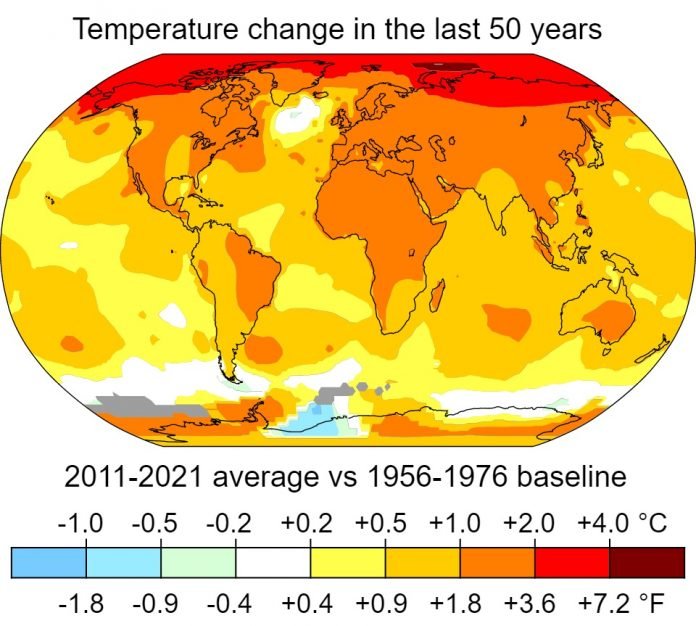A recent temperature-mapping report showed increased temperatures of up to ten degrees in various parts of the ten Virginia cities that participated in the study. The report, organized by the Virginia Foundation of Independent Colleges, was the largest of its kind and aimed to provide the state government with the data they needed to address climate change.
The study reiterated well-understood but important truths about the effects of urban planning on city temperatures, such as the heat-inducing effects of large parking lots and wide streets paved with black asphalt.
The scope and scale of the study was remarkable, recruiting more than 200 volunteers who took 490,423 temperature mapping measurements throughout different routes at various times in the day. Volunteers took measurements in Virginia Beach, Salem, Winchester, Lynchburg, Richmond, Petersburg, Arlington, Abingdon, Harrisonburg, and Farmville.
A vast amount of data was collected in the summer of 2021, made possible by a large number of committed volunteers and their passion for the project. As Todd Lookingbill, Chair of the Department of Geography and the Environment at Richmond University explained, the report would have been impossible to complete without a big group of volunteer workers.
“If it were just me kind of doing this all by myself, it would have taken three months, basically, of constant sampling in order to collect the amount of data, the hundreds of thousands of data points that we were able to collect with all that effort over the course of one day,” Lookingbill stated.
The study also enlisted the help of a number of other Universities in Virginia including Shenandoah University, Virginia State University, the University of Lynchburg, and Roanoke College. The report highlighted not just the dangers of rising temperatures but also the risk of increasingly volatile weather patterns.
Despite being the largest and most comprehensive temperature mapping report of its kind, it was not the first report to detail the effects of climate change and temperature in Virginia cities. In fact, comparable studies have been conducted in Roanoke, Richmond, and Norfolk. Many of these studies reached conclusions that highlighted important environmental issues.
For example, one study showed how communities of color in Richmond were disproportionately affected by rising temperatures. It also highlighted how many of these warmer geographical areas had fewer resources and less sophisticated infrastructure. These findings were consistent with common patterns of inequality with respect to the effects of climate change across many different geographic regions.
Urban heat islands can produce a lengthening of growing seasons and a decrease in air quality due to increases in pollutants like ozone. They can also decrease water quality.
The wide-scale use of asphalt and concrete are some of the main culprits behind urban heat islands, as are tall buildings which can reflect incoming sunlight multiple times. Buildings can also block wind which decreases cooling by convection. Waste heat from industrial factories, air conditioning, and cars can also exacerbate warming.
Urban heat islands can affect surrounding wildlife by disrupting habitats. Communities that can’t afford air conditioning and other cooling systems are at increased risk of heatstroke, heat cramps, and heat exhaustion. Rising temperatures also have an impact on buildings that must maintain specific temperatures to safeguard critical assets like vaccines. According to Dickson Data, temperature mapping can be an effective way to assess the temperature changes in different areas and inform decision-making by leadership.
Temperature mapping has demonstrated the deleterious effects of urban heat islands on disadvantaged communities. Oppressive heat can represent a significant challenge for these communities, leading local governments to explore options that encourage cooling.
Among these strategies include investments in green infrastructure improvements that can lower the temperatures of streets and parking lots. Planting trees and vegetation in urban heat islands is another common strategy to decrease temperatures and improve the environment.
Some densely populated cities have invested in initiatives to plant grass and greenery on rooftops in an effort to reduce temperatures. Often referred to as green roofs, this approach is an ideal strategy for combating urban heat islands by providing direct and ambient cooling effects. Many cities have introduced tax incentives that encourage the creation of green roofs to cool urban heat islands.
In sum, the recent study in Virginia reflects some of the most pressing dangers of urban heating islands and climate change. These findings are consistent with research from around the country, which is why city governments are making investments in cooling strategies today.








